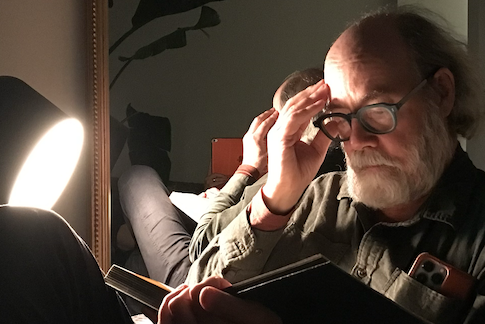
Cool links, and books I've enjoyed recently...
Cool Links
In the old days people used to put collections of links they liked on their personal pages.
I am resurrecting that custom for my own use; but happy if others find it useful.
Geology-related:
• Traveling Geologist: Trip reports that combine narrative and geology by various field geologists.
• Rock-of-the-Month (RotM a-z).: Detailed write-ups of particular specimens, by eminent mineralogist Graham Wilson.
• Geoology blog (RotM a-z).: Detailed write-ups of particular specimens, by eminent mineralogist Graham Wilson.
• Regional: Keweenaw Boulder Garden and Keweenewa Volcanics. In-depth information about Norther MN/MI Geology by Bill Rose of MTU..
• General: Alex Strekeisen Fantastic source of explanations and many many photos by Alessandro Da Mommio. Useful for novices and experts.
• General: Mindat.org ponsored by Hudson Institute of Mineralogy: focused on minerals but good information on rocks. Useful for novices and experts.
• General: Geology is the Way Still exploring this, but appears to be informative site by Samuele Paepschi
'The World Wild Web: Interesting blogs, etc.
• The Indie Web: A starting point for those interested in living beyond the walled-gardens...
• Bartoz Ciechanowski Animated Diagrams: This is worth looking at for the way in which animated diagrams and simulations are used to explain concepts. For instance, take a look at How GPS Works
• Casey Handmerb: A deeply technical blog on space travel, energy, and similar topics. Not frequently updated, but a great source.v
• Cory Doctorow's blog: Among the deepest and most critical thinkers on the presence and future of tech.
• Cosma Rohilla Shalizi Notebooks : Notes, small essays &c on cybernetics, complexity, etc.
• Dave Gauer's Cards: Many short interconnected notes about all kinds of things.
• David O'Hare's site: Essays on nature, environment, &c by a philosopher who has read very widely...
• Parker Glynn-Ady's site: Math, religion, writing...
• Robin Sloan's blog: An engaging and interesting SF author writing on media and tech
• The Autodidact Project
Other
• Word-a-Day Always interesting.
• Cloud Appreciation Society: A delightful organization, and you can get a free peek at the Cloud of the Day...
Recent books
I've enjoyed
Otherlands: A Journey through Earth's Extinct Worlds, David Halliday, 2021.
The best science book I've read in the last decade; a lovely combination of lyrical writing and well-grounded science. A look at ecosystems of the past through the lense of paleontology.
The Tangled Tree: A Radical New History of Life, David Quammen, 2019.
A gripping account of the several revolutions in evolutionary biology from the 1970's on, with close attention to the way science plays out on the ground.
The High Sierra: A Love Story, Kim Stanley Robinson, 2022.
Sort of a natural history of the Sierra Nevada, seen through the lens of a lifelong backpacker (and a favorite SF author of mine); it is a bit of a memoir as well. Will be of interest to avid hikers, backpackers, and those interested in the geology and geomorphology of the Sierra.
Gathering Moss: A Natural and Cultural History of Mosses , Robin Wall Kimmerer, 2003.
An earlier book by the author of "Braiding Sweetgrass." I haven't read Sweetgrass, but very much enjoyed this natural history of mosses. Beautiful.
This is How You Lose the Time War, Amal El-Mohtar and Max Gladstone, 2019.
Science Fiction. Nebula, Hugo and Locus award winner for best novella. A clever and lyrical cross-time love story.
Older Essays
(and one poem)
on Technology
and its Use
(circa '93 - 2015)
For more recent (2018 on) see links to blogs on my home page.
Creating Kairos (2015)
An essay on kairos, and how social media might do better at creating the opportunity for productive interactions.
Empathy or Efficiency (2012)
A short essay reflecting on the differing ways that digital intelligence can be used.
The Future of the Audience
A 750 word sidebar for HCI 2020 that was not published. circa 2011.
Theory, Theory
A favorite; A poem on the role and state of theory in HCI that has been reprinted in two other works. Paul Dourish once said of it" Possibly the first attempt to rhyme "ontology" with ethnomethodology.
Design as Storytelling
About the use of storytelling and how it functions as an analog of sketching in interaction design.
On the Experience of Remote Meetings
Describes a sort of out-of-the-body experience I had as a remote attendee of a meeting; surprisingly relevant for today's hybrid meetings.
A Teleworker's Reflections
ECSCW '01 Position Paper.Also about my life as a teleworker.
Ask Not for Whom the Bell Tolls
Now published in CACM; a fun read.
The World Wide Web as Social Hypertext Thoughts on the web, circa 1995. I feel as though this was a very foresighted paper, even though it missed little things like the rise of advertising.